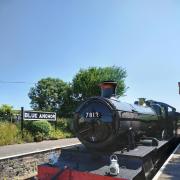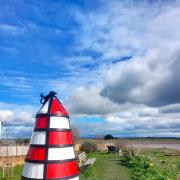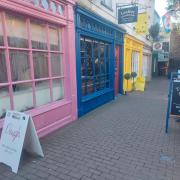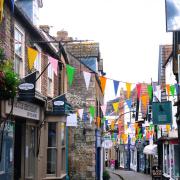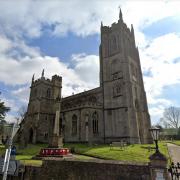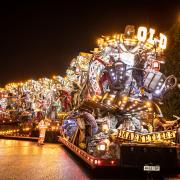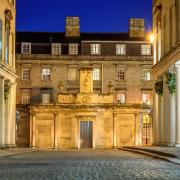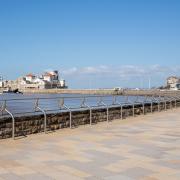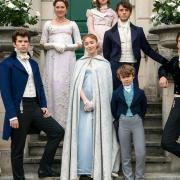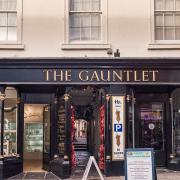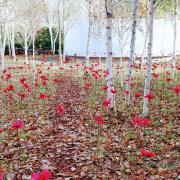Mystic poetesses, riots and ageing rock stars all play their part in Malcolm Rigby's tour of the attractive Somerset market town of Frome. Photos by Neville Stanikk.
Mystic poetesses, riots and ageing rock stars all play their part in Malcolm Rigby's tour of the attractive Somerset market town of Frome. Photos by Neville Stanikk.
The bridge is an appropriate place to start our tour, not least because the town is named after the river - Frome, meaning fast-flowing. Just nearby is the strange V-shaped museum building with Venetian-style round windows, donated as the Literary and Scientific Institute by a wealthy and outspoken benefactor. Across the road is the Blue House, constructed in 1720, it was founded as a school for boys (the pupils had to wear blue coats, hence the name) with almshouses in the wings for elderly women. When I ask Alastair McLeay, Chairman of the Frome Society for Local Study, what were the key moments in Frome's history, he says with an ironic smile: "Nothing important ever happened in Frome, that's one of its delights."Eventually he concedes that there was a fairly major riot here in 1832, mainly around the marketplace and the George Inn. The occasion was Frome's first election following the Reform Act. The Whig Thomas Sheppard was up against the popular but disreputable Sir Thomas Champneys for the Tories; the men were personal enemies. The two sets of supporters met in an orgy of violence and destruction, resulting in one of Sheppard's men dying from his injuries. The Riot Act was read, special constables were introduced, but the battle didn't end until a troop of Dragoons entered the town - Sheppard won the vote. To the left of the Market Place you find the ever-so-charming Cheap Street, a medieval cobbled lane with a conduit flowing down the centre. This is a street that is crammed with small independent shops and always seems to be buzzing. Alastair points out one shop that has an old wooden beam with a Tudor rose carved out of it, as if to prove the age. He also shows me the lane running parallel, Apple Alley, formerly Leg of Mutton Lane, which reveals the rear of the buildings and further illustrates their age.Onwards up the hill and you come to St John the Baptist Church. There's no evidence of any Ancient Briton or Roman activity in this precise vicinity so this is where Frome was founded by St Aldhelm in 685 when he established a monastery. The existing building dates back to the mid-Victorian era, re-modelled by William Bennett from the Oxford Movement. There's little of real age apart from two stones with carvings that were discovered during the digging of the foundations and were then incorporated into the building. Certainly of interest is the Via Crusis that lines the path to the church - stone sculptures of six of the stations of the cross created by James Forsyth.Along the cobbled and aptly named Gentle Street you pass some fine houses and the old brewery on your right, and as you emerge are confronted by a row of Methodist buildings; a church, a school and a headmaster's house. The Revd John Wesley once referred to the town as 'poor dead quarrelsome Frome', and there is a strong tradition of religious nonconformity - everywhere you look there are churches and chapels of various denominations.Going back down Bath Street you find the very excellent Rook Lane Chapel, built in 1707 by James Pope. Derelict from 1967, it was renovated in the '90s by the Somerset Buildings Preservation Trust and even then no one knew what to do with it until NVB Architects stepped in. It is now both an office and a regularly used arts space. Rook Lane House was the retirement home of the 17th-century mystic poetess Elizabeth Rowe, largely unheard of now though she was big in her day, achieving European fame, but she refused to leave her beloved Frome. Other notable personages associated with the town include Sir Benjamin Baker, who was born here. He was an engineer involved with the Forth Bridge, the Aswan Dam, the Metropolitan underground, a New York subway, and he designed the boat that brought Cleopatra's Needle from Egypt to the Thames Embankment. Christina Rossetti, of Pre-Raphaelite fame, ran a school here for a year until it went bust, but perhaps more interestingly the author of Teach Yourself Guide to Sex lived in Frome, and maybe still does.On the main road you come across Christ Church where amongst the expansive graveyard is the tomb of Thomas Bunn, of whom Alastair says: "He was a solicitor who made a fantastic difference to the town. He was the driving force in cutting North Parade and Bath Street through the centre of the town and he was involved in the Somerset and Dorset Canal, which never happened, and also in bringing the railway to Frome."From here we enter the enclosure of wonderful pale yellow terraced housing - the back streets. As Alastair says: "The whole of the area was developed by William Sheppard in the late 17th century, which covers High Street, Wine Street, Sheppard's Barton and the Trinity area, which between them I think are the finest example of early industrial housing in Western Europe. I would really point them out as the gems in Frome. Unfortunately in what was a so-called slum clearance in the 1960s the local authority destroyed half of the Trinity area, and that's typical of the local authorities of the time, they did far more damage than the Luftwaffe ever did."Frome's business was for centuries the cloth industry, bringing population growth and some degree of prosperity, but after the Napoleonic Wars it lost out to the North, failing to adapt to the competitive needs of factory and machine. Other work took its place like Butler & Tanner, the printers. Their splendid old mill in the Trinity area, designed in a neo-Byzantine style, has now been converted into flats. Catherine Hill and Street take you back downhill to the centre, another road resplendent in fascinating independent shops - one in particular called 'Deadly is the Female' catches my eye.A blue plaque on a house in Cork Street marks the spot where the Duke of Monmouth stayed for a couple of nights in June 1685 before embarking on his disastrous confrontation at Sedgemoor. Twelve rebels, not necessarily locals, were later executed in the town.Returning to the car park there are two buildings of note, on the right is the round TIC that was used in the past for cloth drying, and on the left the Cheese and Grain. This is now a popular venue for ageing 1970s rock stars but was a 19th-century market hall to sell exactly what its name suggests.As we part, Alastair sums up his admiration for Frome: "I like its architecture, I like the people, I like the accent, I like the history of the town. It's a very friendly place and it's not too big."On the first Sunday of the month during the summer Alastair MacLeay and his colleagues run a guided town walk, contact 01373 454611 for further details.



